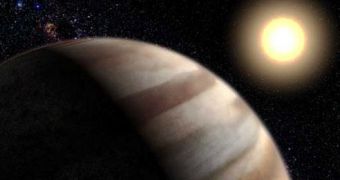A new study performed by astronomers involved in the search for extrasolar planets revealed that there are more chances of a star having Jupiter-like gas giants orbiting around them when the star itself is more massive than our Sun.
It seems that the 10 observations of stars which are more massive than our own support this theory about the formation of planets. Until now, the majority of the 236 known extrasolar planets have been found while looking for the gravitational wobbles that the planets induce in their host stars as they orbit.
Most of the search focused on Sun-like stars, since the lighter ones are more difficult to spot because of the less light they give out and the heavier ones end to rotate very quickly around every 12 hours or so, thus making it hard to spot the signature of any planets.
But recently, astronomers discovered a class of stars about twice as massive as the Sun that have slowed down with age, rotating slowly enough to reveal the presence of planets. The "retired" A stars are around 2 billion years old and are approaching the end of their lives.
John Johnson of the University of California in Berkeley, USS has found many of the stars in this category to have planets in past, around 9 percent of all known retired A stars ever found.
"This is the first indication that stellar mass has an integral role in planet formation," says Johnson. "There's probably a treasure trove of planets around these retired A stars."
At first glance, the formation of planets around these stars may be explained by the fact that planets form from disks of gas and dust around stars, so the bigger the star, the more massive the planet will be. However, none of the discovered planets are close to their stars, most of them being found at a distance in space almost equal to that between the Earth and the Sun.
"There may be a different migration scenario around high-mass stars," says Johnson. "But the exact process that causes this - it's very much a mystery."

 14 DAY TRIAL //
14 DAY TRIAL //